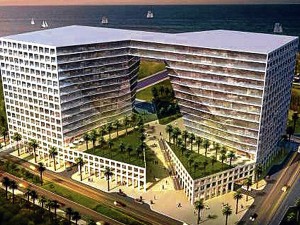By: Tessa R. Salazar
Philippine Daily Inquirer

THE PROPERTY sector’s strength was focused on the vertical developments and the BPOs and the emergence of new growth centers.
Exactly 35 days before 2011 bids adieu, Inquirer Property has asked analysts to assess the performance of the Philippine real estate industry in 2011. Their unanimous reply:
It has been a banner year for the business process outsourcing (BPO) sector.
The mid-income condo development is in the midst of a “construction frenzy.”
The demand for spaces in the Makati, Bonifacio Global City and Ortigas central business districts was even higher this year compared to last year.
The emerging growth centers like Eastwood andBonifacio Global City have “arrived” this year.
Leading global real estate services company Colliers International, which claims its research team had been tracking all the residential condominium developments in Metro Manila since 2008, said that in 2010 preselling activities were able to sell 36,000 units, and that in 2011 that number is projected to be surpassed by more than 11 percent to breach the 40,000 units sold mark.
This was revealed by Paul Vincent Chua, associate director for valuation and advisory services and head of consultancy and research.
Top 5
“There are a lot of developers who performed well this year, however, in terms of condominium units sold in Metro Manila, SM Development Corp. remains to be number one. The top five include developers Ayala LandInc., Century Properties, DMCI and Megaworld,” said Chua.
Enrique Soriano, professor at the Ateneo Graduate School of Business and senior adviser at Wong+Bernstein Business Advisory, also cited Megaworld, ALI, SMDC and Robinsons Land Corp. (RLC) as the top-performing developers in 2011.
Soriano also added that the property sector in 2011 “was single-handledly fueled by private initiatives.”
Soriano also observed “no movement in the high-end condominium segment, and aggressive construction frenzy in the mid-income condo segment representing 80 percent of all residential developments in 2011.”
4% vacancies
Chua said that in terms of commercial space uptake, the demand from the BPO sector is still remarkably high.
“If you look at vacancies in Makati, Bonifacio Global City, and Ortigas, the average vacancy for the third quarter is now less than 4 percent compared to the same period last year, which had an average vacancy rate of more than 6 percent. Even with the (addition of a) number of planned office developments in the next couple of years, we expect vacancies to remain low as the demands for these spaces are still very high.”
Soriano said the industry’s strength was “focused on the vertical developments and the BPOs and the emergence of new growth centers following the success of Eastwood and BGC.”
But have there been any downsides to this year’s flurry of developments? “The singular focus on the mid-income segment, and neglecting other asset classes,” replied Soriano. He reasoned, however, that the property sector was just keeping up with “unmet demand, fueled by buyer demand, especially (from)overseas Filipino workers (OFWs) and overseas Filipino expats (OFEs).
Morale booster
The positive analyses for 2011 and the strength of the Philippine real estate industry this year come as a morale booster, coming at a time when the city of Manila has recently been tagged as “below fair” to “abysmal” by foreign investors in the Emerging Trends in Real Estate Asia Pacific 2011 survey conducted by the Urban Land Institute.
Global real estate investors, who participated in the survey, gave Manila a score of 4.56 points out of a possible 9. Topping the survey in the Asia-Pacific region was Singapore with a score of 5.96 points, followed by Shanghai with 5.87, Mumbai with 5.79 and Hong Kong with 5.70.
Chua countered that the Philippines has been one of the few countries in Asia where foreign land ownership is limited to 40 percent. He urged the sector to look at the brighter side, particularly the lower rental rates compared to other Asia-Pacific countries.
He pointed out that for the office sector alone, with 25 Asia-Pacific cities covered by Colliers International,Makati City offers the third lowest rent, ranking No. 22 on the list with an average net rent of $21.48/square feet. The city that commands the highest rent, Hong Kong, has an average net rent of $185.91/square feet. Looking at the capitalization rate or prime yield of these cities, Makati ranked second with 9.77 percent, following topnotcher Mumbai with 10.6 percent.
Soriano said the low ranking was a wake-up call, and that the Real Estate Investment Trust law must now be implemented in the country, citing Hong Kong, Thailand, Singapore and Malaysia significantly benefiting from REIT. He added that implementing REIT would open more opportunities for investment.
Avail of the opportunity to own a condominium unit in Cebu City for only P12,000.00/month with its own parking lot. Hurry while the supply of units last. Just call the Tel. Nos. shown below.
Tel. Nos. (032)555-8464/09164422611/09173378637
No comments:
Post a Comment